
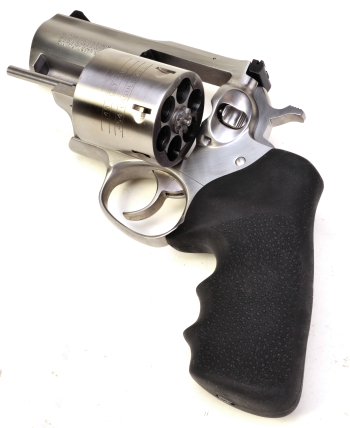 As a function of being chambered for the 454 Casull, the Alaskan probably wouldn’t be my first choice for casual concealed carry for self defense. When it comes to power versus firearm control, my personal limit is probably the .357 Magnum. In regard to bulk and weight, setting aside the Alaskan’s necessarily large 1.800″ cylinder width for a moment, it is dimensionally smaller, and only 4 ounces heavier than a 4″ barrel GP100 .357 Magnum revolver.
As a function of being chambered for the 454 Casull, the Alaskan probably wouldn’t be my first choice for casual concealed carry for self defense. When it comes to power versus firearm control, my personal limit is probably the .357 Magnum. In regard to bulk and weight, setting aside the Alaskan’s necessarily large 1.800″ cylinder width for a moment, it is dimensionally smaller, and only 4 ounces heavier than a 4″ barrel GP100 .357 Magnum revolver.Lots of similarities, but meaningful differences…
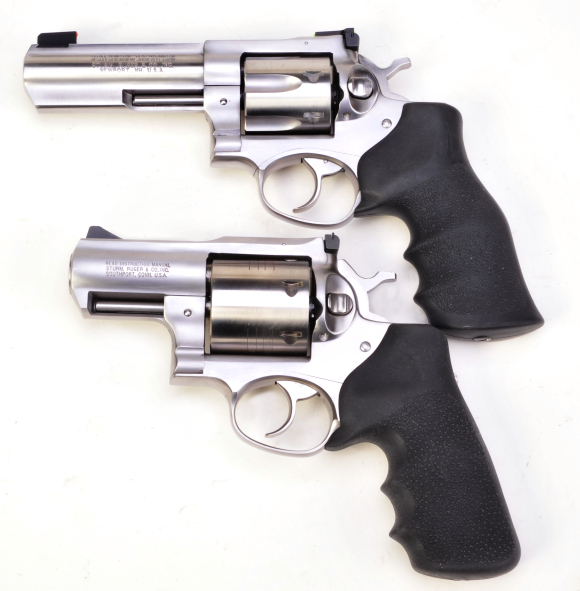
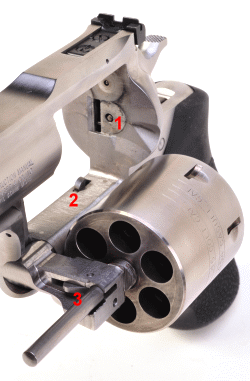 A nice feature of Ruger revolvers is the progressive and proportional strengthening of frames that occurs as revolver models move from small, to medium to large in scale. The changes never undermine a feel common to all Ruger models; balance, heft, grip angle and trigger reach. Mastering one Ruger usually means being able to shoot any and all of them well. An exception here is that where the GP100 grip flares aft at the bottom, the Super Redhawk Alaskan’s grip tucks in and its finger grooves are cut upward which makes for a more substantial hold.
A nice feature of Ruger revolvers is the progressive and proportional strengthening of frames that occurs as revolver models move from small, to medium to large in scale. The changes never undermine a feel common to all Ruger models; balance, heft, grip angle and trigger reach. Mastering one Ruger usually means being able to shoot any and all of them well. An exception here is that where the GP100 grip flares aft at the bottom, the Super Redhawk Alaskan’s grip tucks in and its finger grooves are cut upward which makes for a more substantial hold.
The thickening of the top strap on the Super Redhawk extends all the way across the cylinder and is 0.700″ wide, compared to 0.686″ for the GP100. The frame walls reflect a similar degree of difference. The barrel support areas are reinforced. The breech face of the Redhawk is over 0.200″ larger than the GP100.
Like the GP100, and the SP101 Model Rugers for that matter, the Super Redhawk locks up in three places as illustrated, right; Pawl Plunger 1 Cylinder Latch 2 Front Latch 3. This makes for a very stable assembly.
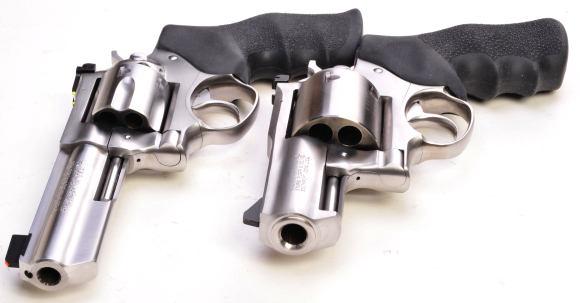
More of the differences between GP and Redhawk models are evident from a front view. The Alaskan has no stepped transition from frame to barrel shroud. The cylinder walls are really beefy with a thickness of 0.125″ compared to 0.105″ for a standard Redhawk chambered for the .45 Colt and only 0.085″ for competitor Taurus’ .44 Magnum. While we’re looking at this end of the gun, unlike the GP100, and other Redhawk and Super Redhawk models, the front sight of the Alaskan is drift pinned in place, rather than secured with dovetail or “press to change” front slight plunger. I think just the fact that this snub nose revolver has a fully adjustable rear sight demonstrates Ruger thought through the application. Most short barrel guns, intended for concealed carry, are point and shoot intended.
Modular design…

The Ruger lines of revolvers are all modular by design and, therefore, very easy to disassemble and maintain. As illustrated above, the grip comes off with one screw which exposes the mainspring assembly. The hammer is cocked, a small takedown pin that is supplied with the gun is inserted in the mainspring strut. The hammer is lowered, offloading the mainspring, and the mainspring assembly is removed.

The hammer pivot and hammer are removed next, then the mainspring strut is used to depress the trigger guard plunger. Actually, this never quite works for me as Ruger gun parts are a tight fit so I just slip a steel punch through the back of the grip frame and pop the guard loose. With the guard removed the cylinder assembly slides right out. Easy, and so is reassembly. No embarrassing bailout trips to the gunsmith to follow.
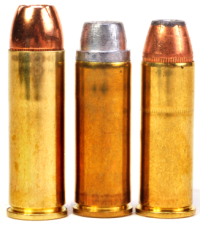 Left to right, .454 Casull, .45 Colt and .44 Magnum. The first two can be fired in the subject version of the Alaskan, however, a .44 Remington Magnum version is also available.
Left to right, .454 Casull, .45 Colt and .44 Magnum. The first two can be fired in the subject version of the Alaskan, however, a .44 Remington Magnum version is also available.
|
||||||||||||||||||
The table data, right, is an excerpt from Hornady’s reloading manual. The loads are maximum and associated with a 7 1/2″ barrel gun. This is where the .454 Casull shines as a relatively extreme cartridge intended for hunting. Combining the Casull with a short barrel gun results in something akin to a short barrel version of the .357 or .44 magnum. While the .454 Casull – short barrel combination may diminish the ultimate potential of the cartridge, the result is a firearm of reduced size and more convenience of carry. The short barrel velocity penalty is approximately 300 fps.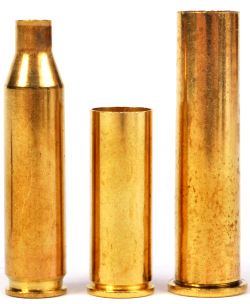
The Casull has a case capacity that is large for a handgun, but not particularly large in comparison to moderate capacity rifle cartridge cases. Sandwiched between the .243 Winchester and .45-70 Gov’t, cases capacity is 54.0, 46.8 and 79.0 respectively. So, if not from immense powder volume, where does the Casull get its power? Mostly from elevated operating pressure levels. The maximum pressure for the Casull is 65,000 PSI, compared to just 14,000 PSI. for the standard .45 Colt. In fact, the Casull reaches pressure levels almost twice that of hot rod Colt handloads that some of us create for special applications and for use in very strong firearms, that sometimes reach 33,000+ PSI.
The Casull’s high pressure presents a quandary. While pressure offers tremendous potential for exceptional ballistic performance, it also taxes components and firearms. Maximum pressure, applied to too lightly tempered cartridge brass, may cause difficulties when an attempt is made to eject empties from a revolver. Adhering to a lower pressure ceiling may be required to assure reliable firearm function. More commonly the problem, high pressures may result in very high velocity that pushed bullets well beyond their design parameters. Virtually all mainstream reloading manuals, authored by bullet manufacturers, cite one or two bullets suitable for use with the .454 Casull. Numerous other bullets originally intended for the laid back .45 Colt are recommended, but only in concert with reduced loads.
Getting this train of thought back on track… The Alaskan’s potential can be reached with less than maximum loads. As is the case with virtually all short barrel guns, they are made for specialized applications and come with performance tradeoffs. Reduced velocity is accepted as a component of a buyer’s decision. When assembling handloads for these types of guns, there is the reality that it does little good to stuff a cartridge chock full of powder in an effort to attain maximum velocity as a good amount of powder will burn beyond the muzzle and not contribute to performance. In fact, shooting the Alaskan at dusk almost gives the appearance of sunrise… actually quite spectacular. More logically, the owner of an Alaskan might work to mainstream reloading manual recommendations and drop down to lesser but still stout 45,000 – 55,000 PSI pressure levels. Velocity will be shaved a bit, but powder spew will be reduced, as will mule kicking recoil, and the reduced velocity will allow the use of many more 0.452″ bullet types designed for the .45 Colt.
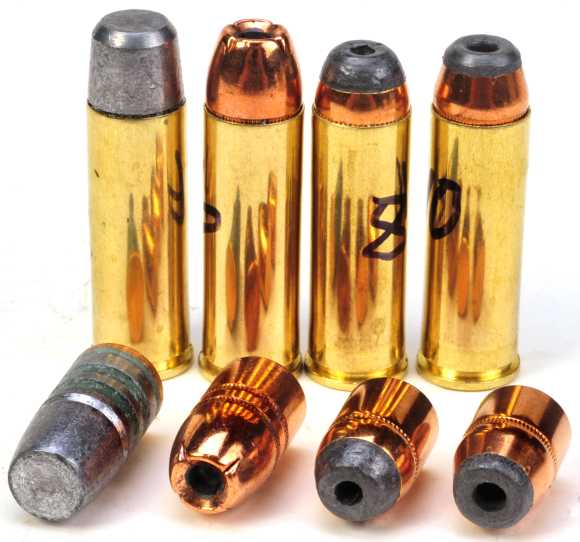
Working up handloads was an interesting part of assessing the Alaskan’s performance and, as a handloader, it was an interesting part of the project. I began with the assumption I would be able to extrapolate from some of my heavy .45 Colt loads and finesse the load data with information from hardcopy mainstream reloading manuals. Actually, not so much… at least not without a bit of trial and error.
Standard small rifle primers worked well, consistent ignition and uniform in velocity. Magnum small rifle primers did not result in the same. I suspect the magnum primers drove bullets forward from fully charged cases, increasing case volume ahead of actual ignition. The result was reduced pressure producing and low and somewhat erratic velocity. Good solid crimps were required for uniform performance, regardless the primer type selected.
H110, my favorite shovel full of smokeless powder for heavy .45 Colt and .44 Magnum loads, did not fare well with the .454 Casull despite trying with several types of combination. Could just be the combination of a short barrel and a disproportionate amount of unburned powder. Could be I was having a bad powder day. Ironically… yes, you read that correctly, ironically, Win 296 loads performed well. Hodgdon’s Lil’ Gun and Alliant’s 2400 produced the best all around performance.
| Bullet | Weight Grains |
Length Inches |
COL Inches |
Powder | Charge Grains |
Velocity FPS |
Energy Ft/Lbs |
| Cast WNFPGC | 360 | 0.930 | 1.760 | Lil’ Gun | 21.0 | 1061 | 900 |
| Cast WNFPGC | 360 | 0.930 | 1.760 | Lil’ Gun | 23.0 | 1222 | 1194 |
| Hornady XTP-Mag | 300 | 0.810 | 1.745 | Win 296 | 28.0 | 1192 | 947 |
| Hornady XTP-Mag | 300 | 0.810 | 1.745 | Win 296 | 32.0 | 1371 | 1252 |
| Speer | 260 | .680 | 1.670 | 2400 | 24.0 | 1203 | 836 |
| Speer | 260 | .680 | 1.670 | 2400 | 26.0 | 1339 | 1035 |
| Sierra* | 240 | .644 | 1.680 | Lil’ Gun | 19.0 | 893 | 425 |
| Sierra* | 240 | .644 | 1.680 | Lil Gun | 26.0 | 1115 | 663 |
|
Maximum COL = 1.765″ Primers = CCI 400 *Target Practice & Medium Game |
|||||||
Velocity is, of course, would not be the Alaskan’s forté… now I’m writing in French… but it’s certainly capable of throwing heavy lead. Where a .357 Magnum typically penetrates about 12″-14″ of our ballistic medium concoction, the .454 Casull 360 grain cast bullet blew through 28″ of the stuff and buried itself deeply in my favorite range rooted maple tree. Not a very scientific study, but it impressed the heck out of me and the tree is recovering nicely.
The gun has the potential for solid accuracy, but the top loads were over my pay grade for revolver shooting accuracy. The best group sizes came with the lightly loaded 240 grain loads with very deliberate slow fire five shot 3″ accuracy at 25 yards shooting from a rest. I could not come within twice that size with any of the heavy loads. Let’s just call the under 3″ group the gun’s demonstrated accuracy and the 6″+ groups my skill limitations with this combination.
In the end…
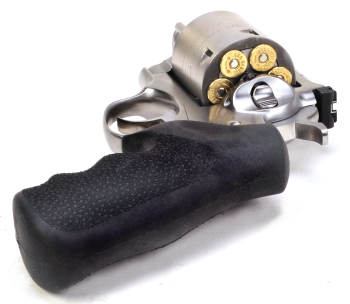
|
||||||||||||||||||||||||||||||
Ruger has done a good job of offering useful accessories for their firearms at their online Ruger Store and the Super Redhawk Alaskan is not an exception. Ruger lists strong side, cross draw and harness carry systems in a price range from $49 to $83, prices dependent upon brand and material. TK, Grovetec and Galco brands are represented, nylon and leather, both right and left hand versions. The store also offers both red and green front light pipe sights for excellent background contrast.

Email Notification